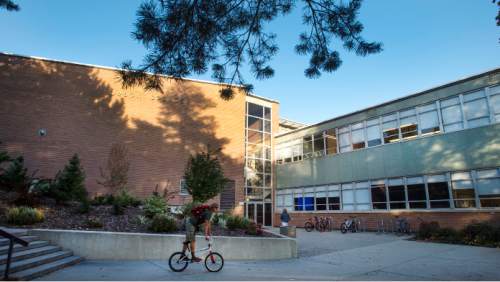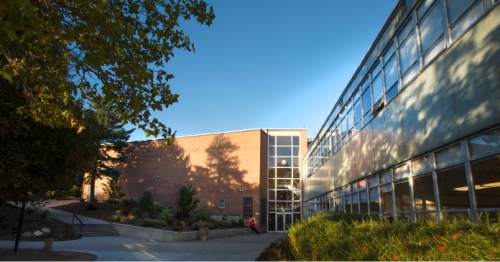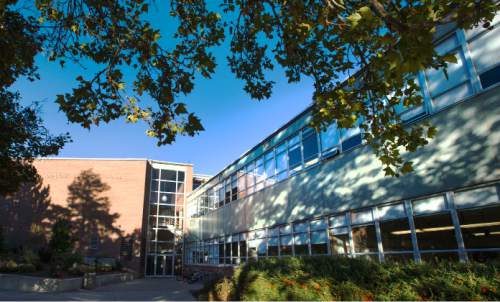This is an archived article that was published on sltrib.com in 2015, and information in the article may be outdated. It is provided only for personal research purposes and may not be reprinted.
Crumbling ceilings and fickle air conditioning. Lecture halls built at the dawn of VHS tapes. Steinway pianos parked next to the body shop.
These are just a few of the brick-and-mortar quandaries facing Utah's arts and humanities scholars back on campus after a summer hiatus. By contrast, campus entrepreneurs and computer engineers around the state are settling into modern classrooms with the highest environmental ratings.
Still, there's hope for the time-honored disciplines. The gap will shrink slightly this fall as the University of Utah drafts a $60 million overhaul of its storied Orson Spencer Hall (OSH). The brick building in the center of campus is set to get the makeover after roughly three generations of students.
One of the school's largest classroom buildings and home of the Hinckley Institute of Politics, OSH is also known as the "worst building on campus," notes student newspaper The Daily Utah Chronicle. With its constant floods, lead paint and asbestos innards, it's in a "constant state of disrepair."
University officers declined to give more details on the makeover or the donors paying for it.
Theirs is not the only ailing space in higher education.
Forty miles south of the flagship university, about 1,800 student artists at Utah Valley University also are hurting.
With no center for the arts, visual and performing-arts students attend classes in a repurposed trade school building with "porous" walls abutting a body shop, said Kendall Newell Dayley, dean of the arts school.
In figure-drawing studio classes, students strain to hear critiques over dueling scales from vocal majors. UVU is one of the nation's 175 "Steinway schools," noted by the piano maker for excellent musical education and top equipment, but the school's own versions of the instruments are stored adjacent to welding equipment and wrenches.
"We do not have a concert hall," Dayley said. "We're using an auditorium that was built for student meetings" or taking a bus to Provo's Covey Center for the Arts.
More than an inconvenience, the lack of space is a health hazard, he said. Dancers flying or sashaying offstage have 4 feet of buffer before hitting a wall.
The campus is the only one in Utah without a home tailored to the arts. In January, for the second year in a row, UVU will ask the Legislature for a $30 million performing arts center for its dancers, actors and painters.
Donors have already supplied half of the cost — $16.5 million. In 2010, Dayley and UVU President Matthew Holland note, the Legislature approved construction of a $45 million science center after the university had raised $2 million.
Meanwhile, a UVU partnership with Vivint allows marketing students at the school's "smart lab" to lead focus groups and track eye movements of consumers reading magazine advertisements. Similarly, renderings of the U.'s Lassonde Institute, set to open next fall, showcase 3-D printers and futuristic dorm "pods."
Recent additions to the U. campus include the Thatcher Chemistry Building, completed in 2013, and the David Eccles School of Business, which also opened two years ago. The $72 million building boasts state-of-the-art technology, space for students to study or lounge and a conference room with glass walls on which students draw with dry-erase markers to puzzle out projects and plans. The Student Life Center, which opened earlier this year, houses several gyms, a climbing wall, an indoor pool and meeting spaces.
The arts have not been forgotten altogether. In 2014, the Beverley Taylor Sorenson Arts and Education Complex opened as the new home to the school's dance program.
It will be another year before OSH falls to bulldozers, but the change is already welcome, said economics major McKay Hill.
Hill says he sees both sides of the construction divide up close. He attends classes in the business school, but also in OSH and the similarly run-down film and media arts building, identified by the U. in a September audit as suffering from "an immediate need for renovation" with a "critical" shortage of computer labs and auditorium space.
The lack of upgrades to the film building, dedicated in 1970, "kind of annoys me," Hill said Tuesday on his way to an elective course on the history of rock 'n' roll.
"I'm kind of pissed off that the business college gets so much," he said.
Hill acknowledges the university is making some long-awaited progress, noting the opening of the U.'s gleaming law school last week, touted for its six stories of eco-friendly glass and improved study space.
Hill would not pick a major solely based on the building, he said, but "if it came to a really close choice where there were no deciders, I might choose because of that."
UVU, hoping to expand its arts program, also sees the weight new surroundings can have.
As envisioned, the Orem university's arts center would house an expansive concert hall, rehearsal studios and training classrooms.
But Daley maintains the sprawling complex is necessary. "We're really not going after a palace for the arts," Dayley said. "We're after a facility that will allow students and faculty to learn together."
Twitter: @anniebknox aknox@sltrib.com











